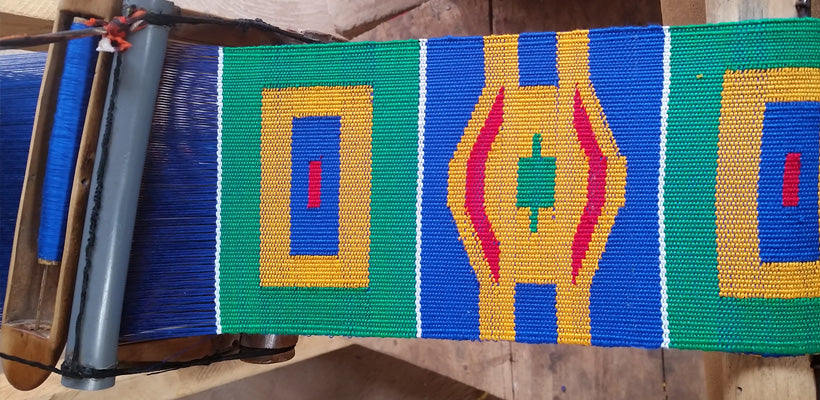Legend has it that Kente weaving originates from a tale of two Akan brothers Nana Kuragu and Nana Ameyaw who one day were hunting in the forest when they came upon the spider Ananse. They stopped and watched as Ananse spun his web and were struck by the intricacies of the woven design. It is then said that after watching for 2 days they took this new found knowledge and began to weave their own threads, to create what is now known throughout the world as Kente. There are obviously other explanations to its origins but everybody loves a legend so lets stick with this!
There is a long history of weaving in Africa which can be traced back thousands of years but Kente as it is now known was developed in the 17th Century. Kente cloth has become synonymous with the Akan people, especially those within the Ashanti Kingdom where the cloth was originally reserved for only those with royal blood, to be worn in times of extreme importance. Now anybody can wear the cloth but it is very expensive and therefore still only worn at events such as weddings and funerals. It is especially interesting that all of the woven designs and coloured threads used have their own meanings. The weaver derives names and meaning from proverbs, moral values, oral literature, philosophy and even individual achievements. The buyer of the kente will therefore not only buy a piece of Kente for its beauty, but also to represent themselves and their beliefs. This tradition of fabric possessing a deeper meaning continues in modern day Ghana and many of the wax print designs available in the market have their own names and meanings, representing something about their wearer.
The colours threads used also are steeped in meaning as shown below;
- Blue – peace, togetherness, love and harmony
- Black – maturity, spiritual energy, mourning, funeral and passing rites
- Gold – high worth, richness, fertility, royalty, prosperity, monetary wealth
- Green – land, crops, vegetation, harvest, growth, spiritual growth and renewal
- Yellow – high worth, richness, fertility, royalty, prosperity, monetary wealth
- Grey – Healing rituals; cleansing rituals; symbolizes ash
- Pink – feminine; mildness and feminine qualities
- White – pureness, cleansing rites and festivals
- Maroon – mother earth and healing
- Red – death; funerals; mourning
- Purple – feminine; worn by girls and women
- Silver – peace and joy; referencing to the moon

On the outskirts of Kumasi, the capital of the Ashanti Region, lie the small villages of Bonwire and Adonmoase, which both have long standing traditions of weaving and are known throughout Ghana as the home of Kente. In these villages Father’s and Grandfathers have passed down their weaving skills through the generations. Weavers tend to learn the trade from a family member and they also tend to be men although some women do weave kente but not as their main trade. I was told women don’t have the ability to concentrate for long periods, we all want to chat too much!! Nowadays not many of the weavers in the village of Adonmoase are actually local to there, instead groups of young men from the Ewe tribe, from near to the border of Togo travel to the Ashanti Region to practice their trade. The methods they use are the same although the patterns and designs can differ due to cultural differences with the Akan people.
Kente is woven on ancient hand looms which are roughly constructed from pieces of wood by their weaver, to fit his size. Once in possession of one of these handmade looms, a weaver will usually work for himself, selling anything that he makes to traders and being paid per piece, this way a weaver is able to work as much or as little as he wants. The looms are operated using both the weavers hands and feet. Crude wooden peddles are attached to strings which separate the layers of the wrap, allowing the weaver to shuttle the coloured threads through the weft to create the design. The noise of this constant passing and clacking is very rhythmic and is heard throughout the large outdoor shed where rows of men sit, listening to music and focusing on their beautiful designs. Their ingrained knowledge of the designs allows them to repeat the same designs multiple times without looking at any plan or instructions!

All of the kente cloth is usually woven into strips called ntomaban or bankuo which are about 3-5 inches wide and about 5-6 feet long. Several strips are then sewn together to make a wider piece of cloth for both men and women. When worn traditionally this cloth is not sewn into clothes but rather draped over one shoulder and wrapped around the body.

Kente is a truly Ashanti fabric and its distinct design is recognised throughout the world. It has inspired many colourful wax print designs, where the patterns are printed, rather than woven onto cotton material. It is these kente prints which are used for lots of the Ashanti Empress clothing whilst we use the original kente for purses, bow ties and bags.
To find out more about the meanings behind the kente designs check out this webpage



